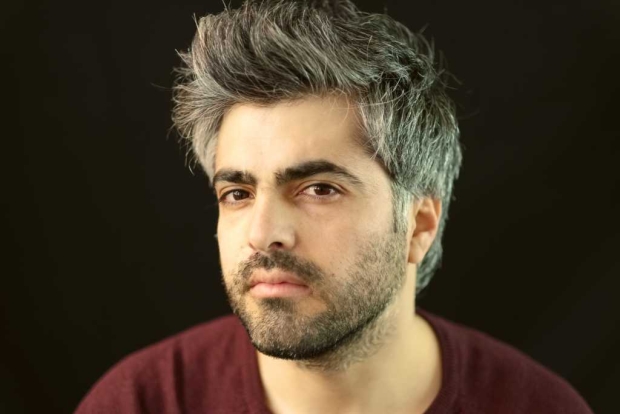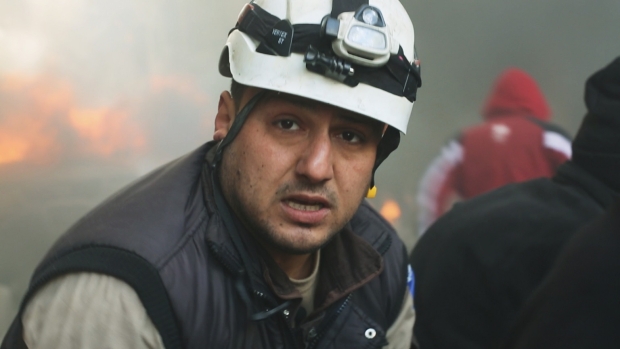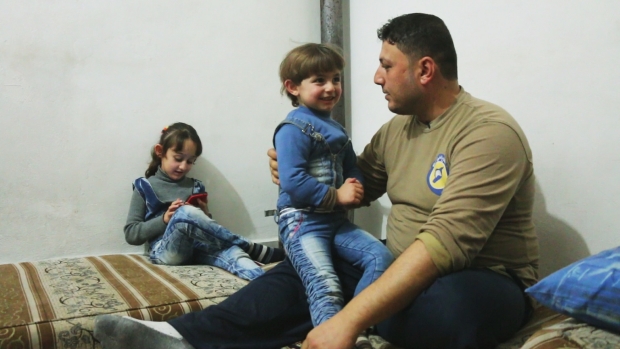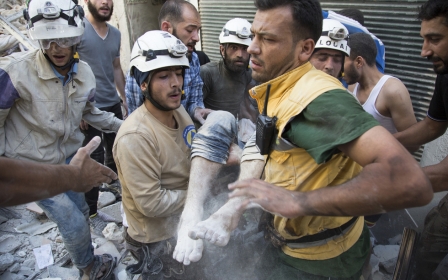'Last Men In Aleppo': 'One day this film will be a document to punish war criminals'

ISTANBUL, Turkey - There comes a time in every war when the difference between good guys and bad ones no longer matters because everything becomes indiscriminate destruction and carnage. And it is the innocent civilians that are left to suffer the consequences.
Fed up with the senseless barbarity that civilians were facing following the Syrian uprising, in 2012 a group of volunteers from various walks of life decided to take on the work of basic civic services that were no longer functioning.
They acted as rescuers, first aid providers, firefighters and a myriad of other things.
The Syria Civil Defence came to be known globally as the White Helmets due to their distinctive white hard hats.
Syrian director Firas Fayyad saw the story of the White Helmets as one that explained what his country was experiencing in the most poignant way.
In his haunting documentary called Last Men in Aleppo, Fayyad shows this world and the humans in it.
“Television screens are filled with stories about the refugee crisis, political meetings, [and] footage of war-created carnage. They forget that it is human beings who are affected by this violence and that people are engaged in a struggle for basic human values,” Fayyad told Middle East Eye.
He said that he wanted the world to become aware and feel the suffering of Aleppo’s residents, Syria’s second-largest city, before they were forced out of their homes at the end of 2016, when forces loyal to Assad closed in on the last pocket of rebel territory in Aleppo, dealing the biggest blow to Syria's rebellion in more than five years of civil war.
The aim of creating awareness was achieved. His haunting and harrowing depiction of the lives and rescue work of the White Helmets in Aleppo was handed the World Cinema Grand Jury prize at this year’s Sundance Film Festival.
The film has also earned positive reviews from publications and industry insiders across the globe.
“There’s no hope, we know how this is going to end, and even a life saved temporarily feels almost as sad as a life lost. Last Men in Aleppo is one of the most difficult documentaries you’ll see this year,” wrote Charlie Phillips in the Guardian newspaper, calling it a must-watch.
Making a film in Aleppo
Trying to film in an Aleppo under constant aerial bombardment was among the toughest of many obstacles that needed to be overcome. Additionally, Fayyad and the film’s Danish co-director Steen Johannessen needed to convince the two characters portrayed in the film that the objective was not about seeking fame.
“There has been times when they get tired of the camera. Sometimes it is taking a lot of work to make them understand why it is so important. Because for them being in front of the camera and part of the film… that is not something they signed up for. They just want to go out and save people and that’s what is important for them,” Johannessen said in an interview on the sidelines of the Sundance Film Festival.
However, he does not fault them, saying that the government of Bashar al-Assad used information gleaned from those media reports to track down and hurt Aleppo residents who opposed his rule.
Fayyad finally won the protagonists over with the following argument:
“It’s a duty to share these stories with people around the world. There are people who are interested in hearing them, that can do something. We need to trust the people we’re going to share the story with, trust that they will take action and trust that one day this film will be a document to punish the war criminals.”
'We need to trust the people we’re going to share the story with, trust that they will take action and trust that one day this film will be a document to punish the war criminals'
Filming had to be abandoned for months at a time, especially when aerial bombardments intensified to the extent that the film’s characters became so despondent and devoid of hope, they saw no point in documenting events.
There were also times, according to Fayyad, when the cinematographer and others naturally abandoned filming, and became rescue workers themselves.
“Sometimes a missile from an aircraft or an explosive barrel would fall next to the cinematographer. Sometimes our work changed to become rescuers due to the injuries around us, and [we had to] forget about our work,” he said.
The film follows White Helmet volunteers Mahmoud and Khaled, both in their 30s, for a year from 2015-16.
Fayyad and Johannessen attain balance in the film by documenting the day-to-day lives of Mahmoud and Khaled, avoiding the trap of focusing on the wider picture and diluting the human element.
Khaled constantly questions whether it is worth remaining in his city with two young daughters, given the constant and seemingly endless destruction he witnesses. Yet he rushes to help after each incident.
The White Helmets was a popular choice for the 2016 Nobel Peace Prize, with 300,000 people signing an online petition backing their nomination.
The cinematographer and others naturally abandoned filming, and became rescue workers themselves
In the end, the Nobel committee gave the prize to the president of Colombia for his efforts in securing a historic peace deal to end 50 years of war with FARC rebels.
Criticism
The group has also faced criticism from activists on social media, mainly for receiving millions of dollars in aid from western governments, including USAID and the UK foreign office.
In October 2016, journalist and activist Max Blumenthal published an "exposé," claiming the group is a political actor in the Syrian civil war, and accusing it of undermining the United Nation's aid effort in Syria.
In his piece, Blumenthal wrote: "The White Helmet's leadership is driven by a pro-interventionist agenda conceived by the western governments and public relations groups that back them."
The group hit back at the criticism and rejected Blumenthal's statements, denying claims that the money donated to the group comes with strings attached and insisting the group's aims were not political.
Personal experiences
Syria’s political woes did play a role in the emergence of the idea behind the film.
Fayyad had completed his degree in art and film-making in his hometown of Aleppo and started working in various media, including print, radio and television, in order to gain professional experience.
Donald Trump’s now court-cancelled Muslim ban was put into effect when he was attending Sundance Film Festival
He then found himself arrested twice in Damascus and tortured by Assad’s government, which made him want to inform the world about what was happening under Assad’s rule.
The first time Fayyad was imprisoned for three months, starting on 30 March 2011. He was teaching people how to become citizen journalists by using their mobile phones to show the atrocities being committed by government forces.
The second time he was imprisoned for eight months, on 30 November 2011. This time it was for a film he had made about the Hama massacre of 1982.
Towards the end of 2012, he decided to move to Turkey, both to be safe and to be able to continue to tell the story of what his country was going through.
The Trump effect
Fayyad was shocked when US President Donald Trump’s now court-cancelled Muslim ban was put into effect when he was attending the event at Sundance in the United States. He arrived in the US two days before the executive order was signed on 27 January.
The now-defunct ban barred all Syrians from entry to the US.
“I am Syrian. I am not ashamed of being Syrian,” Fayyad tells MEE.
He had a similar message during his award acceptance speech at Sundance, and received strong applause when he called on Americans to stand up for the same causes of freedom of speech, humanity and justice as his fellow Syrians were doing.
Fayyad is now back in Denmark, where he moved after spending a few years in Turkey.
Fayyad’s hope is that success at Sundance and further exposure of the documentary will help people all over the world see the human plight and suffering of Syrians.
“I hope this movie gets attention for Syria and motivates [those] who watch it to fight against the racism and hatred against the Syrians. And I hope that this film helps to bring understanding to the conditions of life under the Syrian war,” Fayyad said.
“I also hope it helps to increase support for the White Helmets and the Syrians in the struggle for justice and freedom. And I hope it motivates politicians to stop the war.”
This article is available in French on Middle East Eye French edition.
Middle East Eye propose une couverture et une analyse indépendantes et incomparables du Moyen-Orient, de l’Afrique du Nord et d’autres régions du monde. Pour en savoir plus sur la reprise de ce contenu et les frais qui s’appliquent, veuillez remplir ce formulaire [en anglais]. Pour en savoir plus sur MEE, cliquez ici [en anglais].







